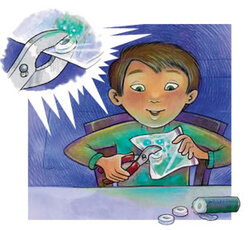what you'll need
Also be sure to ask your mom, dad or another adult to help- they'll want to watch anyway when you tell them how cool this experiment is!
experimental procedure
observations
Does the candy glow in the dark before you crush it? Did you observe a flash of light as you crunched the candy with your pliers? It's not very bright, and it happens very quickly, but you should see a cool flash of light, like a spark. If it doesn't work at first, try again, and make sure the room is dark and your eyes are adjusted. What color is the light? Does it last very long? Does the candy get hot? Cold? If you have different types of candy or some sugar cubes, do you observe any differences in the light from each? If you have a sugar-free mint, does it make a flash of light too? If you have any other candies, try those and make observations.
what's happening
This is not a magic trick or an optical illusion- you really did produce light from an ordinary piece of candy!. This is a demonstration of tribo-luminescence, which means to make light by rubbing, scratching or crushing something, which is very different from most of the ways you are familiar with to make light. Nothing is burning, glowing or getting hot like the filament in a light bulb (although there may be a little heat from the friction as the candy is crushed). It's also not a chemical reaction like the light-sticks you may have played with before. And though it does look sort of like the sparks you see when some metals (like iron) are scratched or scraped by very hard materials (like flint), those are actually produced by spontaneous combustion (burning) of the metal as freshly cut surfaces of very small pieces react with oxygen from the air.
Triboluminescence is not very well understood by scientists, but most think it is similar to the lightning you see during storms or during one of our cool electricity demonstrations, which is actually a type of plasma discharge. Many materials, like the sugar in this experiment, have a very special crystalline structure that causes electrons to be ripped away from the nucleus of their atoms. Since electrons have a negative electrical charge and the protons in the nucleus have a positive charge, separating these charges can create an electrical field strong enough to rip electrons off gas molecules in the air, a process called ionization, and creates a localized plasma. These plasma ions can then slam into other molecules and transfer energy which causes them to emit photons of light. Those are the flashes you observed. Most of the light energy is emitted in the ultraviolet (UV) part of the electromagnetic spectrum, which is just outside the range of light that is visible to humans, but fortunately there is a bit of violet and blue light that we can see. You should have noticed that the flash of light from the Wint-O-Green Life Saver was significantly brighter, and may have also seemed to last a little longer. This is because wintergreen, the flavoring used in these mints, is a natural fluorescent dye called methyl salicylate. Fluorescent molecules can absorb energy of short wavelengths and emit their own light at a longer wavelength. In our experiment the wintergreen in the mint absorbs a lot of UV energy that we can't see, and emits greenish-blue light which we can see, so it appears much brighter to us.
variations and related activities
Try this experiment with ordinary table sugar (which you will have plenty of after you crush all your sugar cubes). Put a few teaspoons into a clear glass cup or dish (a Pyrex measuring cup works great) and slowly grind the sugar with a metal spoon to observe flashes of blue light. Try powdered sugar. You can also do the experiment in your mouth (bite very carefully so you don't break a tooth!) Be sure to look in a mirror so you can see the cool flashes of light in your mouth.
Here's another way to demonstrate triboluminescence: place a piece of Scotch tape onto a glass mirror or plate, then quickly rip it off in the dark. If you're lucky you should see a flash of light, but in our experience this experiment can be very finicky! Others have done this with Duct tape too. As was mentioned earlier, triboluminescence is not fully understood. Maybe you will be the scientist to finally explain this phenomenon! Most scientists believe air molecules play a role and that light should not be produced if the sugar is wet or under water, but we have observed flashes of light in both cases. What about other liquids? Humidity in the air can also affect the results (this is especially true for the scotch tape experiment). Let us know what you observe in your experiments in the Comments blog below.
references and links to more information
Some photos and videos of triboluminescence light flashes:
Others instructions for this experiment: Youtube video showing flashes of light from Duct tape: X-rays from Scotch tape:
Wikipedia article on triboluminescence: Journal paper from Towson State University researchers (yes, real scientists study this!):
Luz de Dulce - Triboluminiscencia (en español)
Admítelo, te encanta comer dulces. Pero, ¿sería aún mejor si sus dulces pudieran producir sus propios destellos de relámpagos? En este experimento, le mostraremos cómo hacerlo.
Lo que necesitarás
Procedimiento experimental
Observacione
¿El caramelo brilla en la oscuridad antes de aplastarlo? ¿Observó un destello de luz mientras machacaba el caramelo con sus pinzas? No es muy brillante y sucede muy rápido, pero debería ver un destello de luz fría, como una chispa. Si no funciona al principio, inténtelo de nuevo y asegúrese de que la habitación esté oscura y sus ojos estén bien adaptados. ¿De qué color es la luz? ¿Dura mucho? ¿Se calientan los dulces? ¿Frío? Si tienes diferentes tipos de dulces o algunos terrones de azúcar, ¿observas alguna diferencia en la luz de cada uno? Si tienes una menta sin azúcar, ¿también produce un destello de luz? Si tiene otros dulces, pruébelos y haga observaciones.
Qué está pasando
Esto no es un truco de magia o una ilusión óptica, ¡realmente produciste luz a partir de un dulce ordinario! Esta es una demostración de triboluminiscencia, que significa hacer luz frotando, raspando o aplastando algo, que es muy diferente de la mayoría de las formas con las que está familiarizado para hacer luz. Nada se quema, brilla o se calienta como el filamento de una bombilla (aunque puede haber un poco de calor debido a la fricción cuando se tritura el caramelo). Tampoco es una reacción química como las barras de luz con las que quizás hayas jugado antes. Y aunque se parece a las chispas que se ven cuando algunos metales (como el hierro) son rayados o raspados por materiales muy duros (como el pedernal), en realidad se producen por combustión espontánea (quema) del metal como superficies recién cortadas de las piezas muy pequeñas reaccionan con el oxígeno del aire.
Los científicos no comprenden muy bien la triboluminiscencia, pero la mayoría piensa que es similar al rayo que se ve durante las tormentas o durante una de nuestras demostraciones de electricidad fría, que en realidad es un tipo de descarga de plasma. Muchos materiales, como el azúcar de este experimento, tienen una estructura cristalina muy especial que hace que los electrones se desprendan del núcleo de sus átomos. Dado que los electrones tienen una carga eléctrica negativa y los protones en el núcleo tienen una carga positiva, la separación de estas cargas puede crear un campo eléctrico lo suficientemente fuerte como para arrancar electrones de las moléculas de gas en el aire, un proceso llamado ionización, y crea un plasma localizado. Estos iones de plasma pueden chocar contra otras moléculas y transferir energía, lo que hace que emitan fotones de luz. Esos son los destellos que observaste. La mayor parte de la energía luminosa se emite en la parte ultravioleta (UV) del espectro electromagnético, que está justo fuera del rango de luz que es visible para los humanos, pero afortunadamente hay un poco de luz violeta y azul que podemos ver. Debería haber notado que el destello de luz del Wint-O-Green Life Saver fue significativamente más brillante, y también pudo haber parecido durar un poco más. Esto se debe a que la gaulteria, el aromatizante utilizado en estas mentas, es un tinte fluorescente natural llamado salicilato de metilo. Las moléculas fluorescentes pueden absorber energía de longitudes de onda cortas y emitir su propia luz en una longitud de onda más larga. En nuestro experimento, la gaulteria de la menta absorbe mucha energía ultravioleta que no podemos ver y emite una luz azul verdosa que podemos ver, por lo que nos parece mucho más brillante.
Variaciones y actividades relacionadas
Pruebe este experimento con azúcar de mesa común (que tendrá en abundancia después de triturar todos los terrones de azúcar). Pon unas cuantas cucharaditas en una taza o plato de vidrio transparente (una taza medidora Pyrex funciona muy bien) y muele lentamente el azúcar con una cuchara de metal para observar los destellos de luz azul. Prueba el azúcar en polvo. También puedes hacer el experimento en tu boca (¡muerde con mucho cuidado para no romperte un diente!) Asegúrate de mirarte en un espejo para que puedas ver los fríos destellos de luz en tu boca.
Aquí hay otra forma de demostrar la triboluminiscencia: coloque un trozo de cinta adhesiva en un espejo de vidrio o un plato, luego rómpelo rápidamente en la oscuridad. Si tiene suerte, debería ver un destello de luz, pero en nuestra experiencia, ¡este experimento puede ser muy delicado! Otros también han hecho esto con cinta adhesiva. Como se mencionó anteriormente, la triboluminiscencia no se comprende completamente. ¡Quizás seas el científico que finalmente explique este fenómeno! La mayoría de los científicos creen que las moléculas de aire juegan un papel importante y que la luz no debería producirse si el azúcar está húmedo o bajo el agua, pero hemos observado destellos de luz en ambos casos. ¿Qué pasa con otros líquidos? La humedad en el aire también puede afectar los resultados (esto es especialmente cierto para el experimento de la cinta adhesiva). Háganos saber lo que observa en sus experimentos en el blog Comentarios a continuación.
referencias y Enlaces a más información
Algunas fotos y videos de destellos de luz triboluminiscente:
Otras instrucciones: Video de YouTube que ensaña la luz usando Duck tape: Radiografías de cinta adhesiva:
Artículo de Wikipedia sobre triboluminiscencia: Artículo de revista de investigadores de Towson State University (sí, ¡científicos reales estudian esto!):
0 Comments
Your comment will be posted after it is approved.
Leave a Reply. |







